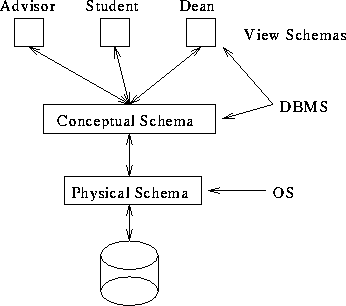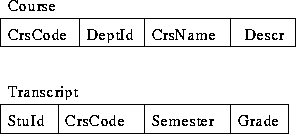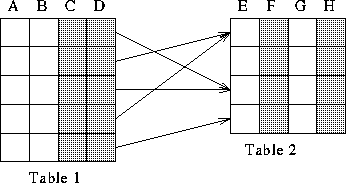- Physical: bits, bytes, and files level.
- Conceptual: The database at the DBMS level.
- View: Generally, constrictions of the conceptual schema.
Supported by the DBMS.

Views used to constrict the data available to a user. Enhance security, privacy, simplicity.
- Conceptual and view schemas.
- Constraints --- conditions which the data must satisfy.
- Data operations --- queries, inserts, deletes, updates.

 consists of a subset,
consists of a subset,  , of
attributes of S with the property that an instance, s, of S satisfies
, of
attributes of S with the property that an instance, s, of S satisfies
 if it does not contain a pair of distinct tuples
whose values agree on all the attributes of
if it does not contain a pair of distinct tuples
whose values agree on all the attributes of  . Also, we
assume no proper subset of
. Also, we
assume no proper subset of  is a key constraint.
is a key constraint.

 is a candidate key for Table 2.
is a candidate key for Table 2.
 of Table 1 references the given candidate key
of Table 2.
of Table 1 references the given candidate key
of Table 2.
 is a list of
attributes in S, and
is a list of
attributes in S, and  is a key constraint in
T. There is a 1-1 correspondence between attributes in
is a key constraint in
T. There is a 1-1 correspondence between attributes in  and
and  . We say that relation instances
. We say that relation instances  and
and  satisfy the foreign key constraint
satisfy the foreign key constraint  references
references
 and that
and that  is a foreign key if and only if
for every tuple
is a foreign key if and only if
for every tuple  there is a tuple
there is a tuple  that has
the same values over the attributes of
that has
the same values over the attributes of  as does s over the
corresponding attributes of
as does s over the
corresponding attributes of  .
.